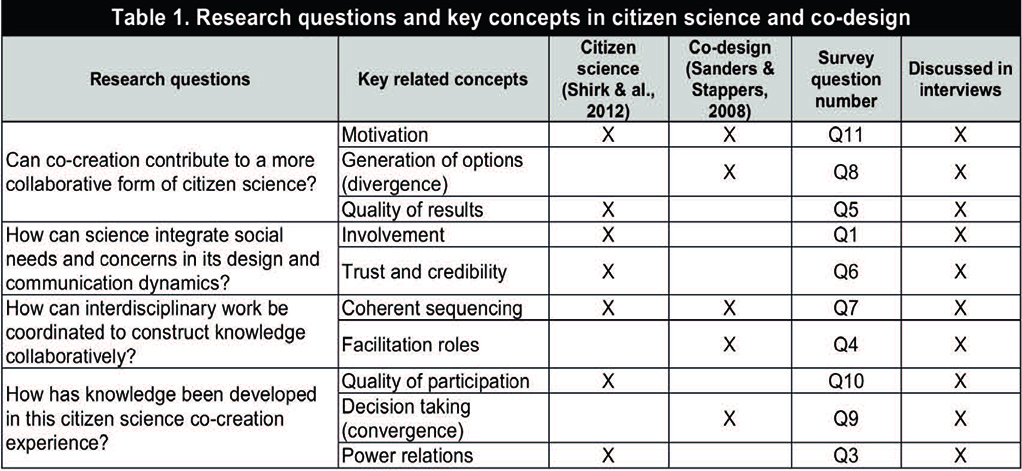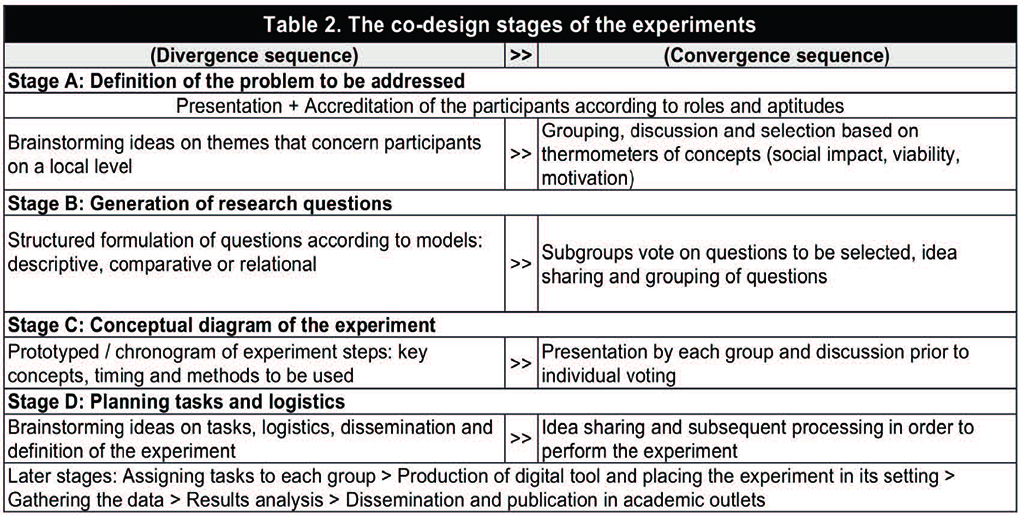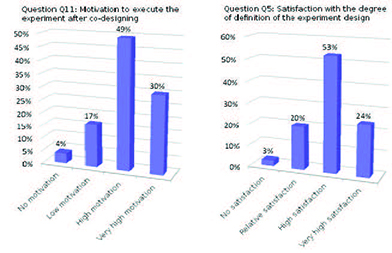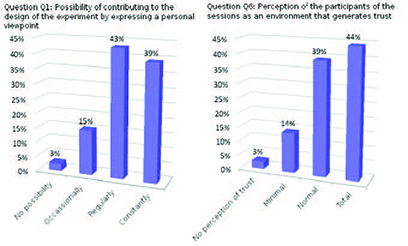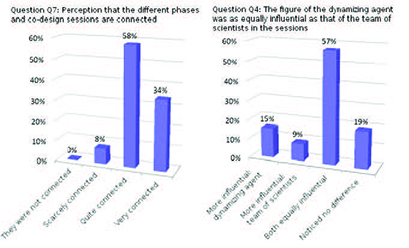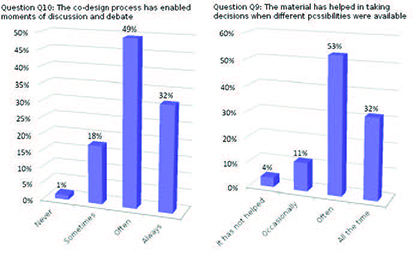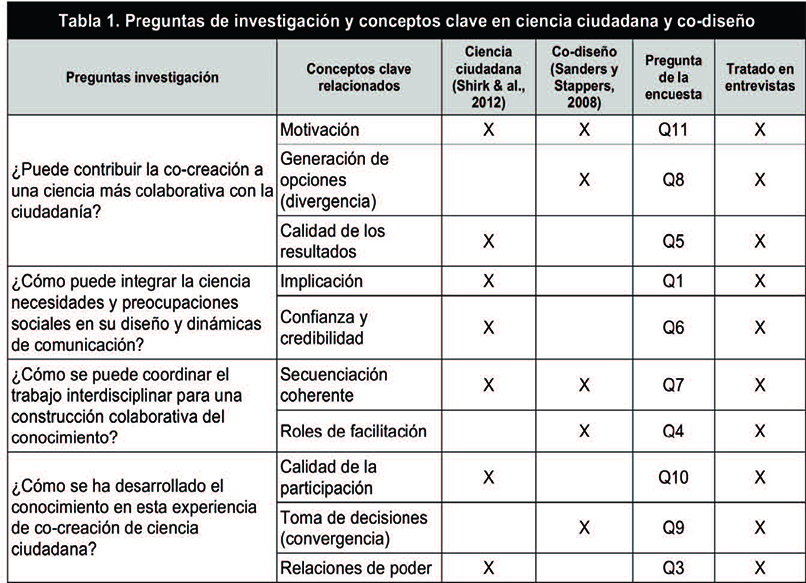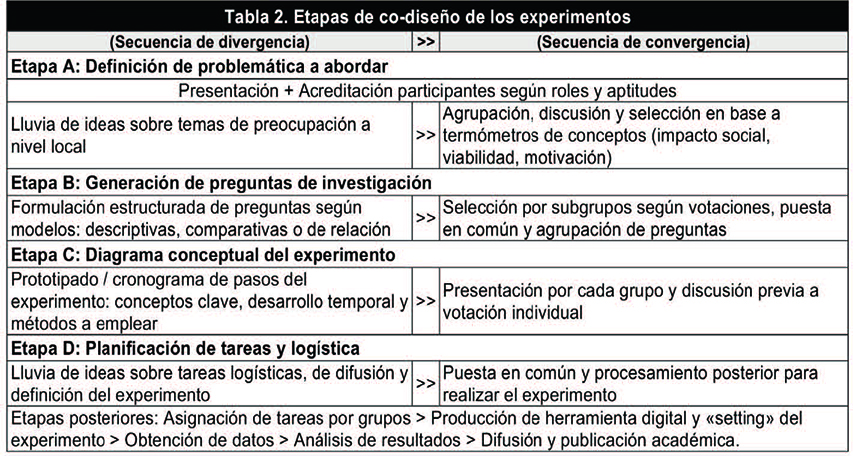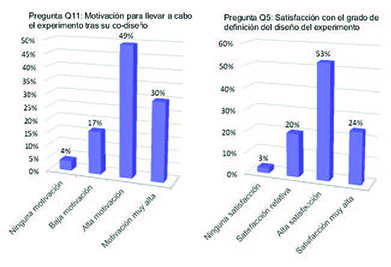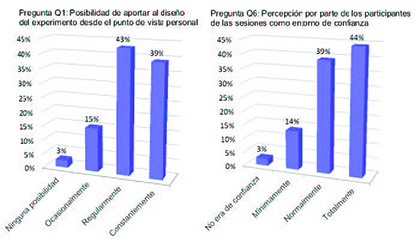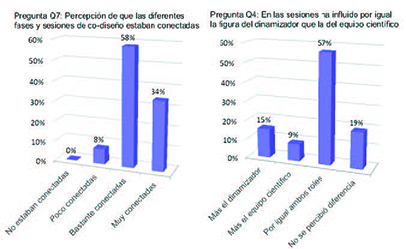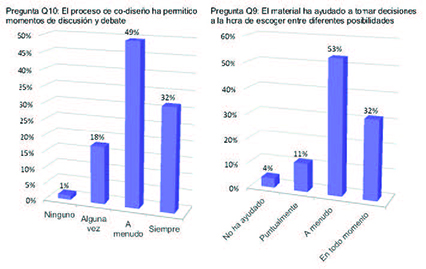Pulsa aquí para ver la versión en Español (ES)
Abstract
This article describes and analyzes the collaborative design of a citizen science research project through cocreation. Three groups of secondary school students and a team of scientists conceived three experiments on human behavior and social capital in urban and public spaces. The study goal is to address how interdisciplinary work and attention to social concerns and needs, as well as the collective construction of research questions, can be integrated into scientific research. The 95 students participating in the project answered a survey to evaluate their perception about the dynamics and tools used in the cocreation process of each experiment, and the five scientists responded to a semistructured interview. The results from the survey and interviews demonstrate how citizen science can achieve a “cocreated” modality beyond the usual “contributory” paradigm, which usually only involves the public or amateurs in data collection stages. This type of more collaborative science was made possible by the adaptation of materials and facilitation mechanisms, as well as the promotion of key aspects in research such as trust, creativity and transparency. The results also point to the possibility of adopting similar codesign strategies in other contexts of scientific collaboration and collaborative knowledge generation
1. The study goal and aim of the analysis
Citizen science represents a participatory research model that involves the public in scientific projects (Irwin, 1995; Hand, 2010; Gura, 2013), usually in data collection (Cohn, 2008) and, in some cases, in the collective interpretation of results (Delfanti, 2016). In the last decade, citizen science has received greater attention and acknowledgement in the academic literature (Follet & Strezov, 2015), in its development mainly in the natural and experimental sciences (Ferran-Ferrer, 2015), and it has transformed investigative methods applied in these fields (Wylie & al., 2014). The normal citizen science model considers collaboration between scientists and “amateur” participants as mere “contributory systems” (Wiggins & Crowston, 2015). Nevertheless, there is a growing number of cases involving greater collaboration on the part of the population at various stages of an investigation (Shirk & al., 2012; Delfanti, 2016), as also occurs in other collective knowledge-generation processes that adopt an open and innovative perspective (Yáñez-Figueroa & al., 2016). Follet and Strezov (2015) define citizen science projects according to the type of voluntary participation:
• Contributory projects: participants take part in data gathering, analyze the data at certain points in the project and help disseminate the results.
• Collaborative projects: as well as the above, the participants analyze samples and, on occasions, help designs the study, interpret data, draw conclusions or disseminate the results.
• Co-created projects: the participants collaborate in all stages of the project, including the definition of the questions, development of hypotheses, discussion of results and response to further questions that might arise.
Authors such as Bonney and others (2009a) point to the need to go beyond the contributory model of citizen science and involve the volunteer in the design process of the research in ways that are more deliberative and accessible. However, compared to the academic literature and resources generated around the contributory and collaborative modalities of citizen science, in the form of guides (Tweddle & al., 2012) or material for facilitation of this process (Bonney & al., 2009b), there is currently very little detailed information on the mechanisms used for the deliberate design of a co-created model of citizen science.
Apart from some pioneering experiences in techno-scientific participation, such as Public Lab (Wylie & al., 2014), conceptual frameworks for public involvement in scientific research (Shirk & al., 2012) and methodologies based on logical models for citizen participation (W.K. Kellogg Foundation, 2004), as opposed to other co-created knowledge-generation settings (Manzini & Coad, 2015) there are few practical resources available to facilitate the co-designing of research process; the exception is urban cartography experiences (Mindell & al., 2017).
This study analyzes how co-design can contribute to the idea that science can be made in collaboration with society. In our study, co-design is defined from an understanding of the co-created modality of citizen science as “participatory science” or “civic science” (Wylie & al., 2014), which encourages the appropriation of both the means that make it possible, and the knowledge generated as a result of a collective investigation. This approach connects with methodological and pragmatic challenges to develop a “co-production framework” or “language of co-production” in research, following the formulations of Jasanoff (2004), and what she terms the “participatory turn” in scientific studies (2003).
With this in mind, this study analyzes the co-design process in three collective experiments of citizen science directed by a team of scientists with experience in co-facilitating and analysing similar experiments in the public space (Sagarra & al., 2016) using collaborative and contributory modalities (Perelló & al., 2017). The case study, whose sequence is described in detail in the third section of this article, is based on an important conceptual difference in design thinking between “co-creation” (the generic process of collective creativity) and “co-design” (a set of specific participatory design techniques), the latter being a specific feature within the broader co-creation setting (Sanders & Stappers, 2008).
Our analysis addresses the following research questions:
• Can co-creation contribute to a more collaborative form of citizen science?
• How can science integrate social needs and concerns in its design and communication dynamics?
• How can interdisciplinary work be coordinated to construct knowledge collaboratively?
• How has knowledge been developed in this citizen science co-creation experience?
2. Methodology of the study
The case under analysis is part of the STEMForYouth (stem4youth.eu) initiative, an European project of the Horizon 2020 programme that aims to encourage young people to study science and technology at the university. Co-creation experiences were organized to design citizen science experiments with three groups of teenagers (95 in total) attending secondary schools in the Barcelona area (Spain) that covered a range of socio-demographic contexts.
To ensure that the research project was truly participatory and co-creative, the participants were involved at the start, from the design phase of the investigation. The co-design process of the experiments, based on a set of materials from a toolkit developed for the task, included collective agreement on the definition of the subject matter, the aims of the research and the research questions, and even the methods and logistics required to carry out the field work1.
This article evaluates this co-created design phase of the investigation, for which a survey and interviews were used to address the research questions posed in the study. These two methods were chosen for the exploratory nature of our study in this relatively novel framework of citizen science, following the example of other advances in this field (Bela & al., 2016). The key aspects covered by the questionnaire and interviews derive from a review of the literature on citizen science (Shirk & al., 2012) and on co-design processes (Sanders & Stappers, 2008), as shown in Table 1.
2.1. Survey ti participating students
Following the co-design sessions for each of the three citizen science projects, an anonymous online questionnaire was sent to all the students who took part (a universe of 95 individuals aged 13 to 17 with an equal gender mix, of whom 79 responded to all the questions (81.4%).
2.2. Interviews with the team of scientifics
Five semi-structured interviews were carried out with all the members of the research team, to support the survey data with an analysis of their perceptions of the interaction that took place during the co-design process. A content analysis of the interviews was made based on the categories presented in Table 1.
The researchers interviewed were: MC, the main researcher, male, aged 42; RS, researcher and project manager, female, 41; AC, researcher in training, female, 27; AF, tesearcher in training, male, 24; CP, researcher and designer, female, 32
Codification was done by two other researchers: one who had conducted the interviews (in this case, also acting as a facilitator of the co-design sessions), and another one who had not participated in the interviews or in the co-design process. Later, each category was tested for reliability to check the level of agreement between the two codifiers. In this study, the overall reliability (0.86) was higher than the indices recommended by Krippendorff (1990) and greater than the 0.80 (alpha) that enables solid and fundamental conclusions to be drawn beyond mere speculation.
3. Description of the co-design process
A “design thinking” dynamic was used to achieve a co-created research design, in which interaction sequences between the different groups of participants were developed. The only premise for initiating the sessions was to describe a previous example of a citizen science experiment in a public space, as well as to focus the new experiment on an aspect of human behaviour.
A series of sessions took place in the three secondary school settings, with some slight variations and adaptions between each, which dealt with the co-designing for each experiment in four stages: (a) the problem to be addressed, (b) research questions, (c) conceptual diagram and (d) planning the tasks for executing the experiment (Table 2). There were 12 sessions in total, each lasting between one and two hours.
A toolkit was developed for use in the majority of the knowledge-generation dynamics. This key material2 was tested in preliminary versions and discussions during its use by the research team, to get a balance between usability and rigor, with the aim of producing a useful co-design toolkit for the collective generation of knowledge within a citizen science framework.
During the four stages, the use of the toolkit was guided by the research team acting as co-facilitators, to connect concepts and clarify doubts, while the main facilitator provided a framework for the work in order to achieve some informal yet specific ways to generate and present visual information, in accordance with participatory design practices (Kensing & Blomberg, 1998).
The aim of each session was to perform a divergence and convergence sequence (Brown & Katz, 2011). That is, to generate ideas and possibilities in a participatory way (a sequence of divergence: normally done by forming sub-groups) and a later coming-together to select options (convergence sequence): through idea-sharing and decision-taking mechanisms.
• Stage A: Identifying the collective problem to be addressed. Initially, to stimulate the use of a range of skills within each working subgroup (formed of 6-8 participants), it was proposed that the students select a badge to identify a role they wished to adopt from a set of investigator roles and profiles. Later, the students were invited to brainstorm types of problems for which an experiment on human behaviour could generate evidence of requiring actions to be taken for the improvement of a neighbourhood or city. The parameters used to reach a consensus within each group-class were concepts like the “viability” of the experiment, the “social impact” of the results or the “motivation” necessary to carry it out. Students’ opinions were posted on the walls and compared using thermometers.
• Stage B: Generation of research questions. For the co-creation of specific research questions, each subgroup used a template on which they could stick Post-its enabling them to complete at least three questions that started: What would happen if…? What is the relation between? How…? In this cooperative way, they completed predefined syntagms that, in modular form, contained the different research question options: descriptive, comparative and relational (Onwuegbuzie & Leech, 2006). Later, a moment of convergence based on discussion and the visual selection of the best options helped to filter the most relevant research questions for the group as a whole.
• Stage C: Conceptual diagram of the experiment. The third co-design stage took the research questions selected by each group to a more exploratory and creative level, linking a sequence of concepts around the experiment like action flows through a chronogram. This dynamic followed the premise that the investigation should be designed collectively from its initial steps to ensure the commitment and alignment of all those involved (Barnes & al., 2006). The participants chose icons from a wide range of images that reflected the key aspects of a potential experiment: research methods; logistics; key concepts or variables; participants; and other elements to visualize. These “dense diagrams” reopened debate and conversation about viability and motivation, and helped in the selection of an experiment co-design from among the various “finalists”.
• Stage D: Task planning and logistics. Based on the final selection of objectives and sequences (one related to perceptions of public space and infrastructure in the city, another to gender and discrimination, and a third experiment concept centered on inequality and immigration), each session aimed to move on from the co-design paradigm to preliminary planning. Here the participants dealt with the logistics and tasks required to execute each experiment, in this way ensuring scientific rigor by gathering data and obtaining relevant results for all the agents involved. In this instance, the toolkit provided a surface divided into columns like a basic “kanban” table, which made tasks that might have gone unnoticed both agile and explicit (Hines & al., 2004).
Each column focused on a category of tasks derived from the icons used in the prototype selected, in which the participants brainstormed ideas that they considered appropriate for an experiment (the performance of which, following the earlier participatory stages are seen in Table 2, took place in various public spaces).
4. Results
We present the main results of the study based on the student survey and interviews with the team of scientists. These results link the research questions to the theoretical fundamentals and key concepts of citizen science and co-design (Table 1) following the co-design sequence in the four stages previously described (Table 2).
4.1. Can co-creation contribute to a more collaborative form of citizen science?
The researchers were convinced that student participation in the design of the experiment was vital from the first moment. In the interviews, they were critic with the role of the expert in citizen science (RS, MC) and expressed a desire “to make science truly participatory” (LD). They were initially concerned about whether the subject chosen by the participants would belong to a setting in which they, as researchers, were sufficiently experienced (RS).
Before beginning the co-design process, the researchers’ intention to boost the participation of other actors in the design of the investigation had given rise to doubts: drawing up research questions in collaborative fashion (RS) could be a more complex process than letting the researchers do it themselves (RS, LD); the complexity of not knowing how a co-creation experience could evolve and end (LD); the casuistry of the schools and the populations, which could at times make managing the activity more complex (MC, LD). However, after various co-design stages had been completed, there was a consensus that the initial expectations had been more than satisfied (RS, CP, MC), and that motivation was considerably higher when the non-expert was involved from the beginning (AF, LD). The high level of motivation and commitment achieved through co-creation is also reflected in the responses of the 79 participants to the survey (Figure 1, question Q11), and clearly connects with the scientists’ assessments, such as the “engagement of the citizens with citizen science projects is key for ensuring the success and sustainability of the projects” (RS).
The contribution to the research of the visual material in the co-design toolkit was also analyzed. The material was adapted to the needs of each phase of discussion (MC, CP), and fulfilled the main objective to provide a common language (LD) that reflected ideas that would later be selected (AF, RS). The material was considered essential by 49% of the student participant in conceiving the experiments, and 35% thought it was relevant for enabling the acquisition of new knowledge; 15% found it quite useful and 0% thought it was of no use (Q8).
In terms of the quality of the results, the interviewees stated that the investigation had been democratized (AF, CP) and it yielded perspectives that had not been considered before (RS), including unforeseen circumstances: “the students took a critical stance on many occasions, more than I expected” (LD). The participants expressed satisfaction with the scope of the definition of the experiment design (Figure 1, question Q5), and declared that the experience had been enriching, while also emphasizing (compared to other forms of research design) the challenge to maintain this spirit of co-creation and transparency alive in the following collaborative phases of production, execution and analysis of results (RS, LD, MC).
Despite discrepancies regarding the extent of definition in some of the final conceptual maps (CP, AF), or on the level of detail in the tasks to be undertaken that were identified collectively (MC), the interviews reveal that the co-designing done with the students produced themes, research questions and experiment preparation that were useful (LD) and, in some cases, contained a level of detail that was unexpected (RS).
4.2. How can science integrate social needs and concerns in its design and communication dynamics?
The interviews with the research group show that the collaborative method described helped integrate the participants’ local concerns into the investigation (RS, LD, CP). For example, RS stated that “the design process arose when the themes were decided and a genuine concern emerged; the connection with local problems has been very clear”.
In the survey, most students agreed that they had been able to get involved by expressing their personal points of view (Figure 2, question Q1). The interviews also reveal that the level of involvement, when dealing with a subject close to their concerns and interests, increased student commitment to carrying out the experiment (RS, LD, AF). The students acknowledged the usefulness of the toolkit in discussing and contrasting their concerns (RS, CP), and how the result of the dynamics established to delimit the subjects of the experiments “was closely related to the way in which the participants perceive society and the problems of their surroundings” (CP).
The generation of an environment of credibility and mutual confidence was considered essential for the various stages of co-creation (CP, MC), since the dynamizing agent and the scientists could have been perceived as intruders in the classroom, which could have diminished motivation and contributions. The survey showed (Figure 2, question Q6) that the majority of students had no problem in freely expressing their opinions and only a few felt insecure.
4.3. How can interdisciplinary work be coordinated to construct knowledge collaboratively?
Various interviewees considered that interdisciplinary work and the collaborative production of knowledge can be facilitated thanks to this type of co-design: “each can take a step back from their individual discipline and establish peer-to-peer dialogues” (RS), “many people with different viewpoints have generated knowledge together, beyond one single disciplinary field” (LD). In addition, sharing ideas was highly rated by the researchers after each session (RS, LD, CP), in which preliminary results were put in order, and they could try to predict the outcome of the next ones, thereby bringing coherence. The impression that the different phases of the co-design process were connected as an ordered sequence was confirmed by the majority of participants (Figure 3, question Q7).
It is also important to note that the team of scientists defined themselves as session co-facilitators exercising a support role to clear up doubts (LD, AF, CP), unblocking discussions that occurred in specific groups (RS) or making initial presentations to help students contextualize the investigation (MC). It is also relevant that the students did not appreciate any difference in the influence of the figure of the main dynamizing agent and that of the co-facilitators of the research group (Figure 3, question Q4). This understanding also underlines the interdisciplinary question and the importance of combining scientific knowledge and specific facilitation skills for co-creation.
The research team mainly agreed that these co-creation techniques can be transferred to any scientific project design (RS, LD) and can help to channel scientific discussion (AF); however, most recognize the need for some experience and competence in conducting the co-creation dynamics in citizen science. “In the end, it is a question of finding a balance between democratizing science and the experience of the scientists” (AF), and that in terms of interdisciplinary work, “the researchers did not establish a knowledge hierarchy over the students” (LD).
4.4. How has knowledge been developed in this citizen science co-creation experience?
The collaborative development of knowledge was based on the crucial participation of the students. RS describes the process as a design “validated by the participants themselves”. In the relation between the team of scientists and the students, the former describe this experience as an adaptive process (RS, CP) that is highly flexible (LD) and eminently cyclical: “when you begin the sessions, you realize that is not such a good idea to be so linear; and if you allow them a certain amount of freedom and open up options, then new things can be introduced at the last minute. Allowing for some room for manoeuver is a good idea” (MC).
Regarding the materials, the scientific team considered that the combination of toolkit activities and their facilitation “generated debate and dialogue by integrating diversity through co-design, gathering different opinions and introducing them into the discussion and moments of reflection” (CP). This observation connects with the result in the survey for the question related to the quality of the participation: a clear majority of students agreed that the process allowed them moments for discussion and debate (Figure 4, question Q10).
Despite the fact that some interviewees referred to the complexity of carrying out collective decisions and of managing this requirement within the time limits of each session, which were perceived as very intense (RS, MC, AF), involvement with the co-facilitation dynamics and the associated toolkit materials meant that the entire process was more open (RS); another achievement was a “visualization of difficult concepts” (LD) and, in general terms, the necessary adaptation of the materials and mechanisms in order for decisions to be taken (AF, CP), which again was acknowledged in the survey (Figure 4, question Q9).
With the team of scientists agreeing that the following stages of the investigation required further processing of the co-design results (RS, MC, LD), another key aspect to emphasize is the recognition that the design of the experiment, as was intended, faithfully reflected the work performed by all the participants at all times, with no single influence prevailing at any time, with the team of scientists declining to adopt a position of power (LD, CP, AF). This perception was supported by the result in the survey (question Q3) in which 77% of those polled stated that the design of the experiment reflected the work carried out by all the participants in the work sessions with the team of scientists, against 23% who declared that the design was very much influenced by the team (and 0% who said the results were only the work of the scientific team). This connects to the recurring question of the degree of influence exerted by the experts during the sessions, about which CP states: the themes discussed were not influenced by the scientific team, which is very positive as the students could feel part of the process”.
Finally, another aspect that stands out was the team of scientists’ generalized perception that the co-design techniques applied here could be transferred to other forms of citizen science (RS, MC, LD) and even to other types of scientific research projects (RS, CP). In this sense, the co-design of the experiments can be understood as another experiment in itself, in this case one of participation and consensus generation (MC), and as a good initiation experience in the co-created model of citizen science (RS, LD) whose results enable an exploration of even greater levels of participation in the collaborative design of an investigation (CP).
5. Discussion and conclusions
By describing the process and analysing the results of this case study, we have tried to address the question of how collaboration in citizen science can be strengthened by co-created designs for investigation, attending to a wide range of interests and joining social and scientific objectives (Bonney & al., 2014). We describe the mechanisms that enable clear and specific objectives to be fixed for each experiment, identifying various possibilities by iterative design processes (Dickinson & al., 2012). For example, we describe how the research questions can be formulated as a process driven by the participants themselves, instead of the usual top-down schema dictated by the expert scientist (Newman & al., 2012).
The data obtained from the research questions enable us to draw the following conclusions:
• Co-creation, adopting visual material and participatory design techniques that allow the generation and selection of ideas provide quality results for a science that is more open to citizens, and which is more collaborative. In particular, co-creation is perceived as a fundamental factor in participants’ motivation and commitment, a key aspect in citizen science projects.
• Citizen science can integrate social needs and concerns into its design and communication dynamics if, at the start of the co-creation process, it can generate the actors’ trust in the process. Initiating the mechanisms for decision taking preliminary to any investigation is valued by the participants as an important aspect of successful integration.
• Good coordination of interdisciplinary work is very important for achieving good collaborative generation of knowledge. In this context, coordination requires coherent sequencing of the various co-design phases in which scientific experts fully integrate their expertise with roles of facilitation of group dynamics.
• A key question is a good balance relations of power during the entire process, ceding the initiative to the amateur participants in a structured way while retaining the role of scientific expert, but as guide and reference point at key moments, using as support mechanisms and material that generate reflection and debate.
The results suggest that the toolkit functioned well as a support of design techniques to integrate the diversity of viewpoints and opinions in visual form (Brown & Wyatt, 2015). As both the survey and interviews reveal, this material also encourages interdisciplinarity and can channel co-creation onto a structured visual canvas, something that, despite exceptions (Nagle & Sammon, 2016), constitutes an innovative contribution this study to the design of research processes.
Among the limitations and the need for greater analysis of this type of co-creation developed in this citizen science experience, it is important to mention complications arising from time management in the development of co-design by phases. A recurring comment in the interviews was the complexity of managing each session compared to traditional research design processes, in particular satisfactorily combining the moments when ideas are generated with collective decision taking. Also, certain deficiencies were detected in some co-design sequences during analysis such as in the initial identification of roles (not adequately applied when forming groups), or in the final phases in which the interface and protocol of the experiments were defined in greater detail. Future research that analyzes similar co-creation dynamics in the design of the investigation, whether in the citizen science environment or other settings involving public participation in knowledge, should consider these aspects when planning the development of co-design activities.
As well as the key questions posed at the start of this study, the responses of the team of scientists also suggest that this type of co-design can be extrapolated to scientific and academic interdisciplinary settings where the general public, the non-expert or so-called amateurs are absent from a terrain occupied by experts from various fields. In other words, the possibility of adopting similar co-creation dynamics for the design of research projects in professional teams with different scientific challenges.
Notes
1 It is important to underline that the analysis centers on the initial phase of the co-creation of these citizen science experiments, before the following phases of organization and subsequent execution of each of the experiments, which also count on direct student involvement.
2 The version of the toolkit used is available for consultation online or use by third parties, to promote the reproduction of the co-designing processes of experiments: https://goo.gl/xoU8vJ.
Funding agency
This study has received support from the European Union’s Horizon 2020 Reserach and Innovation Programme, under grant agreement, No. 710577 (StemForYouth), the Spain’s State Research Agency (AEI-MINEICO), and the European Regional Development Fund (FEDER) (FIS2016-78904-C3-2-P), from the Spanish Ministry of Science and Innovation project “Open Access to Science in Spain” (CSO2014-52830-P), as well as from the Dimmons group, IN3/UOC.
References
Barnes, T.A., Pashby, I.R., & Gibbons, A.M. (2006). Managing collaborative R&D projects development of a practical management tool. International Journal of Project Management, 24(5), 395-404. https://doi.org/10.1016/j.ijproman.2006.03.003
Bela, G., Peltola, T., Young, J. C., Balázs, B., Arpin, I., Pataki, G., ... & Keune, H. (2016). Learning and the transformative potential of citizen science. Conservation Biology, 30(5), 990-999. https://doi.org/10.1111/cobi.12762
Bonney, R., Ballard, H., Jordan, R., McCallie, E., Phillips, T., Shirk, J., & Wilderman, C.C. (2009a). Public Participation in scientific research: Defining the field and assessing its potential for informal science education. A CAISE Inquiry Group Report. Online Submission. (https://goo.gl/wsZYQn)
Bonney, R., Cooper, C.B., Dickinson, J., Kelling, S., Phillips, T., Rosenberg, K.V., & Shirk, J. (2009b). Citizen science: a developing tool for expanding science knowledge and scientific literacy. BioScience, 59(11), 977-984. https://doi.org/10.1525/bio.2009.59.11.9
Bonney, R., Shirk, J.L., Phillips, T.B., Wiggins, A., Ballard, H.L., Miller-Rushing, A.J., & Parrish, J.K. (2014). Next steps for citizen science. Science, 343(6178), 1436-1437. https://doi.org.10.1126/science.1251554
Brown, T., & Katz, B. (2011). Change by design. Journal of Product Innovation Management, 28(3), 381-383. https://doi.org.10.1111/j.1540-5885.2011.00806
Brown, T., & Wyatt, J. (2015). Design thinking for social innovation. Annual Review of Policy Design, 3(1), 1-10. (https://goo.gl/1pgucj)
Cohn, J.P. (2008). Citizen science: Can volunteers do real research? BioScience, 58(3), 192-197. https://doi.org/10.1641/B580303
Delfanti, A. (2016). Users and peers. From citizen science to P2P science. Cell, 21, 01. https://doi.org/10.1641/B580303
Dickinson, J.L., Shirk, J., Bonter, D., Bonney, R., Crain, R.L., Martin, J., ... & Purcell, K. (2012). The current state of citizen science as a tool for ecological research and public engagement. Frontiers in Ecology and the Environment, 10(6), 291-297. In G. Papadopoulos (Ed.), Proceedings of the 9th International Conference KICSS. Limassol, Cyprus, 6-8 Nov 2014, 446-451. https://doi.org.10.1007/978-3-319-27478-2
Ferran-Ferrer, N. (2015). Volunteer participation in citizen science projects. El Profesional de la Información, 24, 6, 827-837. https://doi.org/10.3145/epi.2015.nov.15
Follett, R., & Strezov, V. (2015). An analysis of citizen science based research: Usage and publication patterns. PloS One, 10(11), e0143687. https://doi.org/10.1371/journal.pone.0143687
Gura, T. (2013). Citizen science: Amateur experts. Nature, 496(7444), 259-261. https://doi.org/10.1038/nj7444-259a
Hand, E. (2010). People power. Nature, 466(7307), 685-687. https://doi.org/10.1038/466685a
Hines, P., Holweg, M., & Rich, N. (2004). Learning to evolve: A review of contemporary lean thinking. International Journal of Operations & Production Management, 24(10), 994-1011. https://doi.org/10.1108/01443570410558049
Irwin, A. (1995). Citizen science: A study of people, expertise and sustainable development. London: Taylor & Francis. https://doi.org/10.4324/9780203202395
Jasanoff, S. (2003). Technologies of humility: Citizen participation in governing science. Minerva, 41(3), 223-244. https://doi.org/10.1023/A:1025557512320
Jasanoff, S. (Ed.). (2004). States of knowledge: The co-production of science and the social order. London: Routledge. (https://goo.gl/xBNB3C)
Kellogg, W.K. (2004). Using logic models to bring together planning, evaluation, and action: Logic model development guide. Battle Creek, Michigan: WK Kellogg Foundation. (https://goo.gl/pCPB52)
Kensing, F., & Blomberg, J. (1998). Participatory design: Issues and concerns. Computer Supported Cooperative Work (CSCW), 7(3-4), 167-185. https://doi.org/10.1023/A:1008689307411
Krippendorff, K. (1990). Metodología de análisis de contenido: teoría y práctica. Barcelona: Planeta.
Manzini, E., & Coad, R. (2015). Design, when everybody designs: An introduction to design for social innovation. Cambridge, MA: The Mit Press (https://goo.gl/FRJV3B)
Mindell, J.S., Jones, P., Vaughan, L., Haklay, M., Scholes, S., Anciaes, P., & Dhanani, A. (2017). Street Mobility Project: Toolkit. (https://goo.gl/yxDuXk)
Nagle, T., & Sammon, D. (2016). The development of a Design Research Canvas for data practitioners. Journal of Decision Systems, 25(sup1), 369-380. https://doi.org/10.1080/12460125.2016.1187386
Newman, G., Wiggins, A., Crall, A., Graham, E., Newman, S., & Crowston, K. (2012). The future of citizen science: Emerging technologies and shifting paradigms. Frontiers in Ecology and the Environment, 10(6), 298-304. https://doi.org/10.1890/110294
Onwuegbuzie, A.J., & Leech, N.L. (2006). Linking research questions to mixed methods data analysis procedures 1. The Qualitative Report, 11(3), 474-498. (https://goo.gl/dJZ7An)
Perelló, J., Ferran-Ferrer, N., Farré, S., & Bonhoure, I. (2017). Secondary school rubrics for citizen science projects. In C. Heredotouand, E. Scanlon, & M. Sharples, (Eds.), Citizen inquiry: Synthesising science and inquiry learning. London: Taylor and Francis. [In press].
Sagarra Pascual, O. J., Gutiérrez-Roig, M., Bonhoure, I., & Perelló, J. (2016). Citizen Science Practices for Computational Social Science Research: The Conceptualization of Pop-Up Experiments. Frontiers in Physics, 3(93), 1-14. https://doi.org/10.3389/fphy.2015.00093
Sanders, E. (2006). Design serving people. Cumulus Working Papers, 28-33. (https://goo.gl/JXqodm)
Sanders, E., & Stappers, P.J. (2008). Co-creation and the new landscapes of design. Co-design, 4(1), 5-18. http://doi.org/10.1080/15710880701875068
Shirk, J., Ballard, H., Wilderman, C., Phillips, T., Wiggins, A., Jordan, R., ... & Bonney, R. (2012). Public participation in scientific research: A framework for deliberate design. Ecology and Society, 17(2). https://doi.org/10.5751/ES-04705-170229
Tweddle, J.C., Robinson, L.D., Pocock, M.J.O., & Roy, H.E. (2012). Guide to citizen science: developing, implementing and evaluating citizen science to study biodiversity and the environment in the UK. London: Natural History Museum and NERC Centre for Ecology & Hydrology for UK-EOF. (https://goo.gl/9QSBHr)
Wiggins, A., & Crowston, K. (2015). Surveying the citizen science landscape. First Monday, 20(1). https://doi.org/10.5210/fm.v20i1.5520
Wylie, S.A., Jalbert, K., Dosemagen, S., & Ratto, M. (2014). Institutions for civic technoscience: How critical making is transforming environmental research. The Information Society, 30(2), 116-126. https://doi.org/10.1080/01972243.2014.875783
Yañez-Figueroa, J.A., Ramírez-Montoya, M.S., & García-Peñalvo, F.J. (2016). Systematic mapping of the literature: Social innovation laboratories for the collaborative construction of knowledge from the perspective of open innovation. In Proceedings of the Fourth International Conference on Technological Ecosystems for Enhancing Multiculturality (pp. 795-803). ACM. https://doi.org/10.1145/3012430.3012609
Click to see the English version (EN)
Resumen
Este artículo describe y analiza el diseño colaborativo de un proyecto de investigación de ciencia ciudadana a través de la cocreación. Tres grupos de estudiantes de centros de educación secundaria y un equipo de científicos idearon de forma participada tres experimentos sobre comportamiento humano y capital social en espacios públicos y urbanos. El objetivo del estudio es abordar cómo pueden integrarse en una investigación científica el trabajo interdisciplinar y la atención a preocupaciones y necesidades sociales, así como la construcción colectiva de preguntas de investigación. Los 95 estudiantes participantes en el proyecto respondieron una encuesta para evaluar su percepción sobre las dinámicas y herramientas utilizadas en el proceso de cocreación de cada experimento, y los cinco científicos respondieron a una entrevista semiestructurada. Los resultados de las encuestas y entrevistas demuestran cómo la ciencia ciudadana puede alcanzar una modalidad «cocreada» más allá del paradigma habitual «contributivo», el cual únicamente suele implicar al público o amateurs en la recopilación de datos. Esta modalidad de ciencia más colaborativa con la ciudadanía fue posible gracias a la adecuación de materiales y mecanismos de facilitación, así como al fomento de aspectos clave en una investigación como pueden ser la confianza, la creatividad y la transparencia. Los resultados apuntan también hacia la posibilidad de adoptar estrategias similares de codiseño en otros contextos de colaboración científica y generación colaborativa de conocimiento
1. Aproximación al objeto de estudio y objetivo de análisis
La ciencia ciudadana representa un modelo de investigación participada que involucra al público en proyectos científicos (Irwin, 1995; Hand, 2010; Gura, 2013), habitualmente para la recolección de datos (Cohn, 2008) y en algunos casos para la interpretación colectiva de resultados (Delfanti, 2016). En la última década las prácticas de ciencia ciudadana han experimentado un creciente reconocimiento en la literatura académica (Follet & Strezov, 2015), desarrollándose principalmente en ámbitos de ciencias naturales y experimentales (Ferran-Ferrer, 2015) y transformando la forma de investigar en los citados campos (Wylie, Jalbert, Dosemagen, & Ratto, 2014).
El modelo más extendido de ciencia ciudadana suele considerar las formas de colaboración entre científicos y participantes «amateurs» meramente como «sistemas de contribución» (Wiggins & Crowston, 2015). Sin embargo, existe un número creciente de casos en los que esa colaboración supone una implicación más estrecha de la población en diferentes etapas de una investigación (Shirk & al., 2012; Delfanti, 2016), al igual que sucede en otros procesos colectivos de generación de conocimiento desde una perspectiva de innovación abierta (Yañez-Figueroa & al., 2016). Según Follet y Strezov (2015), los proyectos de ciencia ciudadana pueden clasificarse en función de su tipo de participación voluntaria en:
• Proyectos contributivos: los participantes contribuyen en la recopilación de datos y puntualmente ayudan a analizarlos y difundir resultados.
• Proyectos colaborativos: los participantes también analizan muestras y en ocasiones ayudan a diseñar el estudio, interpretar los datos, sacar conclusiones o difundir los resultados.
• Proyectos co-creados: los participantes colaboran en todas las etapas del proyecto, incluyendo definición de preguntas, desarrollo de hipótesis, discusión de resultados y respuesta a nuevas preguntas.
Autores como Bonney y otros (2009a) apuntan a la necesidad de rebasar el modelo contributivo de ciencia ciudadana, para así involucrar a los voluntarios en el proceso de diseño de la investigación de modos más deliberativos y facilitados. Sin embargo, en comparación con literatura académica y recursos generados en torno a las modalidades contributivas y colaborativas de ciencia ciudadana, en forma de guías (Tweddle & al., 2012) o materiales de facilitación (Bonney & al., 2009b), a día de hoy existe escasa evidencia detallada de los mecanismos empleados para el diseño deliberado de un modelo co-creado de ciencia ciudadana.
Más allá de experiencias pioneras de participación tecno-científica como Public Lab (Wylie & al., 2014), de marcos conceptuales para la implicación del público en la investigación científica (Shirk & al., 2012) o de metodologías basadas en modelos lógicos para la participación cívica (W.K. Kellogg Foundation, 2004), en claro contraste con otros ámbitos de generación co-creada de conocimiento (Manzini & Coad, 2015) actualmente existen pocos recursos prácticos de facilitación para el co-diseño de procesos de investigación, exceptuando casos como algunos experimentos de cartografía urbana (Mindell & al., 2017).
El presente estudio aborda cómo el co-diseño puede contribuir a que la ciencia se lleve a cabo de forma colaborativa con la sociedad. En este caso, se perfila desde una concepción de la modalidad co-creada de ciencia ciudadana como «ciencia participada» o «ciencia cívica» (Wylie & al., 2014), promoviendo la apropiación tanto de los medios que la hacen posible como del conocimiento generado fruto de una investigación colectiva. Esta aproximación conecta con desafíos metodológicos y pragmáticos para un «marco co-produccionista» o «lenguaje de co-producción» en la investigación, siguiendo los planteamientos de Jasanoff (2004) y lo que la autora denomina el «giro participativo» de los estudios científicos (2003).
Con ese ánimo, se analiza el proceso de co-diseño de tres experimentos colectivos de ciencia ciudadana, a cargo de un equipo científico con experiencia previa en haber co-facilitado y analizado experimentos similares en el espacio público (Sagarra & al., 2016) bajo modalidades colaborativas y contributivas (Perelló & al., 2017). El caso de estudio, cuya secuencia se describe en la tercera sección del artículo, parte de una distinción conceptual importante en el pensamiento de diseño entre «co-creación» (proceso genérico de creatividad colectiva) y «co-diseño» (conjunto de técnicas específicas de diseño participativo), siendo este último un ámbito específico dentro del más amplio de la co-creación (Sanders & Stappers, 2008).
Nuestro análisis trata de avanzar en las siguientes preguntas de investigación:
• ¿Puede contribuir la co-creación a una ciencia más colaborativa con la ciudadanía?
• ¿Cómo puede integrar la ciencia necesidades y preocupaciones sociales en su diseño y dinámicas de comunicación?
• ¿Cómo se puede coordinar el trabajo interdisciplinar para una construcción colaborativa del conocimiento?
• ¿Cómo se desarrolla el conocimiento en experiencias de co-creación de ciencia ciudadana?
2. Metodología del estudio
El caso analizado se enmarca dentro de la iniciativa STEMForYouth (stem4youth.eu), un proyecto europeo del programa Horizon 2020 para fomentar las carreras de ciencia y tecnología entre la juventud, donde se organizaron experiencias de co-creación para diseñar experimentos de ciencia ciudadana con tres grupos diversos de estudiantes (un total de 95), de diferentes centros de educación secundaria del área de Barcelona (España) con contextos socio-demográficos diferenciados.
Para asegurar que el proyecto de investigación fuese realmente participado y co-creado, se implicó a los participantes desde la fase de diseño de la investigación. El proceso de co-diseño de los experimentos, basado en un conjunto de materiales o toolkit desarrollado para tal fin, comprendió desde la definición conjunta de la temática, objetivos y preguntas de investigación, hasta los métodos y logística para realizar el trabajo de campo1.
En este artículo se presenta la evaluación de dicha fase de diseño co-creado de la investigación, para la que se utilizaron encuestas y entrevistas sobre las preguntas de investigación del estudio. Se optó por ambos métodos dado el carácter exploratorio de nuestro estudio, en el marco aún novedoso de la ciencia ciudadana, siguiendo el ejemplo de otros avances en este campo (Bela & al., 2016). Los aspectos clave abordados mediante ambos métodos proceden tanto de revisión de literatura relativa a ciencia ciudadana (Shirk & al., 2012) como a procesos de co-diseño (Sanders & Stappers, 2008), tal como indica la Tabla 1.
2.1. Encuestas a los alumnos participantes
Tras las sesiones de co-diseño de cada uno de los tres proyectos de ciencia ciudadana se realizó una encuesta online anónima a todos los participantes (un universo de 95 individuos de entre 13 y 17 años, con un balance de género equilibrado, del cual 79 respondieron la totalidad de las cuestiones planteadas (81,4% de representatividad).
2.2. Entrevistas al equipo científico
Se realizaron cinco entrevistas semiestructuradas, cubriendo el total de miembros del equipo de investigadores, para reforzar los datos de la encuesta con un análisis de percepción sobre la interacción durante el proceso de co-diseño. Se procedió a realizar un análisis del contenido a partir de las categorías expuestas en la Tabla 1.
Los investigadores entrevistados fueron MC: Investigador principal, varón, 42 años; RS: Investigadora y manager de proyecto, mujer, 41 años; AC: Investigadora en formación, mujer, 27 años; AF: Investigador en formación, varón, 24 años; CP: Investigadora y diseñadora, mujer, 32 años.
La codificación fue realizada por otros dos investigadores, uno que había conducido las entrevistas (en este caso, además como facilitador de las sesiones de co-diseño) y otro que no había participado ni en las entrevistas ni en el proceso de co-diseño. A continuación se realizó el test de fiabilidad para cada categoría, permitiendo comprobar el índice de acuerdo entre ambos codificadores. En este estudio la fiabilidad en su conjunto (0,86) está por encima de los índices recomendados por Krippendorff (1990) e incluso por encima de 0,80 (alpha), nivel que permite llegar a conclusiones sólidas y fundamentadas, más allá de especulaciones.
3. Descripción del proceso de co-diseño
Para conseguir un diseño de investigación co-creado se siguió una dinámica de «design thinking» en la que se desarrollaron secuencias de interacción entre los diferentes grupos de participantes. Se partió de la única premisa de iniciar las sesiones explicando un ejemplo previo de experimento de ciencia ciudadana ubicado en el espacio público, así como la condición de centrar el nuevo experimento en algún ámbito del comportamiento humano.
En los tres centros educativos tuvieron, con leves variaciones y adaptaciones, una serie de sesiones que constituyeron cuatro etapas para el co-diseño de cada experimento: (a) problemática a abordar, (b) preguntas de investigación, (c) diagrama conceptual y (d) planificación de tareas para ejecutar el experimento (Tabla 2). Se realizaron un total de 12 sesiones, de entre 1-2 horas de duración cada una.
Para ello se creó un conjunto de herramientas de facilitación o toolkit, que sirvió de base para la mayoría de dinámicas de generación de conocimiento. Ese material clave2 fue sometido a una serie de versiones preliminares y discusiones durante su utilización por parte del equipo de investigadores, tratando de encontrar un equilibrio entre usabilidad y rigor, con el fin de crear un toolkit de co-diseño útil para el propósito de generación colectiva de conocimiento en un marco de ciencia ciudadana.
Durante las cuatro etapas, la utilización guiada del toolkit contó con el equipo de investigadores como co-facilitadores, actuando como conectores de conceptos y para aclarar dudas, mientras la figura de un facilitador principal pautaba el trabajo para lograr modos informales pero concretos de generar y presentar información visual, acordes con las prácticas del diseño participativo (Kensing & Blomberg, 1998).
En cada sesión se trató de seguir una secuencia de divergencia y otra de convergencia (Brown & Katz, 2011). Esto es, para generar ideas y posibilidades de forma participativa (secuencia de divergencia: normalmente mediante la formación de subgrupos) y a continuación seleccionar conjuntamente opciones (secuencia de convergencia: mediante puestas en común y mecanismos de toma de decisiones).
• Etapa A: Identificación de la problemática colectiva a abordar. Inicialmente, para promover la diversidad de habilidades en cada subgrupo de trabajo (formado por entre 6 y 8 participantes), se plantearon un conjunto de insignias identificativas, para las cuales los participantes tuvieron que seleccionar entre diferentes perfiles o roles de investigación.
Posteriormente se invitó a los estudiantes a expresar mediante una lluvia de ideas los tipos de problemática donde un experimento sobre el comportamiento humano generase evidencias para activar acciones de mejora de un barrio o de una ciudad. Los parámetros utilizados para llegar a un consenso dentro de cada grupo-clase fueron conceptos como «viabilidad» del experimento, «impacto social» de los resultados o «motivación» para llevarlo a cabo. Las opiniones de los alumnos se reflejaban y comparaban en termómetros específicos ubicados en la pared.
• Etapa B: Generación de preguntas de investigación. Para la co-creación de preguntas específicas de investigación, cada subgrupo utilizó una plantilla donde ubicar «postits», mediante los cuales articular cooperativamente al menos tres oraciones siguiendo la misma estructura. Así completaron sintagmas predefinidos (¿Qué pasaría si…? ¿Cuál es la relación entre…? ¿Cómo…?), que contenían de manera modular diferentes opciones para una pregunta de investigación: descriptiva, comparativa y relacional (Onwuegbuzie & Leech, 2006). Posteriormente, un momento de convergencia basado en la discusión y selección visual de las mejores opciones ayudó a filtrar las preguntas de investigación más relevantes para todo el grupo.
• Etapa C: Diagrama conceptual del experimento. La tercera etapa del co-diseño llevó las preguntas de investigación seleccionadas en cada grupo a un modo más exploratorio y creativo, enlazando una secuencia de conceptos en torno al experimento como flujo de acciones a lo largo de un cronograma. Dicha dinámica siguió la premisa de que el diseño de la investigación debería ser detallado colectivamente desde sus primeros pasos, para asegurar así el compromiso y la alineación de todos los implicados (Barnes & al., 2006). Los participantes seleccionaron iconos de un gran conjunto de imágenes que reflejaban aspectos clave en torno a un posible experimento: métodos de investigación; logística; conceptos o variables clave; participantes; y otros elementos a visualizar. Tales «diagramas densos» activaron nuevamente discusiones y conversaciones sobre factibilidad y motivación, para así seleccionar un co-diseño de experimento entre varios «finalistas».
• Etapa D: Planificación de tareas y logística. Partiendo de los objetivos y secuencias finalmente seleccionadas (una relacionada con percepciones sobre el espacio público e infraestructuras en la ciudad, otra con el género y la discriminación y, por último, un tercer concepto de experimento centrado en la igualdad y la inmigración), cada sesión trató de pasar del paradigma de co-diseño a uno de planificación preliminar. Así se pudo plantear la logística y las tareas necesarias para la ejecución de cada experimento, garantizando tanto su debido rigor científico como la obtención de datos y resultados relevantes para todos los agentes implicados. Para ello, el toolkit proporcionó una superficie dividida en diferentes columnas como tablero «kanban» básico, invitando a hacer ágiles y explícitas tareas que de otro modo podrían pasar inadvertidas (Hines & al., 2004). Cada columna enfocaba una categoría de tareas derivadas de los iconos utilizados en el prototipo seleccionado, donde los participantes realizaron una última lluvia de ideas sobre lo que creían necesario para llevar a cabo el experimento (cuya ejecución, tras las etapas posteriores de participación enumeradas en la Tabla 2, tuvo lugar en distintos espacios públicos).
4. Resultados
A través de las encuestas a los estudiantes y las entrevistas al equipo científico, presentamos los principales resultados del estudio. A su vez, los resultados enlazan las preguntas de investigación con los fundamentos teóricos y conceptos clave de ciencia ciudadana y co-diseño (Tabla 1) siguiendo la secuencia de co-diseño en cuatro etapas arriba descrita (Tabla 2).
4.1. ¿Puede contribuir la co-creación a una ciencia más colaborativa con la ciudadanía?
Los investigadores estaban convencidos de que era imprescindible la participación de los estudiantes en el diseño de la investigación desde el primer momento. Expresaron durante las entrevistas una posición crítica con el rol del experto en ciencia ciudadana (entrevistados RS, MC) y una voluntad de «hacer ciencia participada de verdad» (LD). Aunque también manifestaron preocupaciones iniciales sobre si el tema escogido por los participantes acabaría siendo en un ámbito en que ellos como investigadores estuvieran suficientemente capacitados (RS).
Antes de empezar el proceso de co-diseño, la intención de los científicos en aumentar la participación de otros actores en el diseño de la investigación iba acompañada de ciertas dudas: elaborar de forma colaborativa preguntas de investigación (RS) puede ser un proceso más complicado que llevarlo a cabo solo por parte de los investigadores (RS, LD); la complejidad de no saber cómo puede evolucionar y acabar una experiencia de co-creación (LD); las casuísticas de las escuelas así como de las poblaciones, que podían volver más compleja en algunos momentos la gestión de las actividades (MC, LD). Sin embargo, tras las diferentes etapas de co-diseño hubo consenso en que se superaron las expectativas iniciales (RS, CP, MC), y que la motivación resultaba marcadamente superior contando con la implicación del no-experto desde un inicio (AF, LD). La motivación y el compromiso logrados mediante la co-creación también se refleja en las respuestas del conjunto de 79 participantes en la encuesta (Figura 1, pregunta Q11), y conecta claramente con valoraciones expresadas como que el «engagement» de los ciudadanos con proyectos de ciencia ciudadana es clave para asegurar el éxito y sostenibilidad de los proyectos (RS).
También se analizó la ayuda aportada por los materiales visuales que componían el toolkit de co-diseño de investigación. Adaptados a la necesidad de cada fase de discusión (MC, CP), cumplieron con el objetivo principal de permitir un lenguaje común (LD) que reflejara ideas para posteriormente seleccionarlas (AF, RS). Un material que el 49% de los participantes también percibió como clave para idear los experimentos, y un 35% incluso relevante para ayudar a la adquisición de nuevo conocimiento, frente a un 15% que lo encontró parcialmente útil, y un 0% de ninguna utilidad (pregunta Q8).
En cuanto a la calidad de los resultados, según los entrevistados se había conseguido democratizar la investigación (AF, CP), al tiempo que se dio con perspectivas que no se tenían en mente (RS), incluyendo circunstancias no previstas: «los alumnos tienen mucho espíritu crítico, más de lo que yo esperaba» (LD). Además de los niveles de satisfacción de los participantes con el grado de definición del diseño del experimento (Figura 1, pregunta Q5), todos los miembros del equipo científico manifestaron que el proceso fue enriquecedor, al tiempo que evidenciaban (en comparación con otros modos de diseñar la investigación) el reto de continuar con ese espíritu de co-creación y transparencia en las siguientes fases colaborativas de producción, realización y análisis de resultados (RS, LD, MC).
Pese a discrepancias en el grado de definición de algunos de los mapas conceptuales finales (CP, AF) o el nivel de detalle de las tareas a llevar a cabo identificadas colectivamente (MC), de las entrevistas se desprende también que fruto del co-diseño junto a los estudiantes se lograron unas temáticas, preguntas de investigación y una preparación del experimento útiles (LD), en algunos casos con un nivel de detalle no esperado (RS).
4.2. ¿Cómo puede integrar la ciencia necesidades y preocupaciones sociales en su diseño y dinámicas de comunicación?
En las entrevistas al equipo de investigadores se evidencia que el método colaborativo descrito ayudó a integrar en la investigación las preocupaciones locales (RS, LD, CP). Por ejemplo, el participante RS expresaba que «el proceso de diseño nació en el momento que se decidió la temática y surgió de una inquietud real, la conexión con los problemas locales ha sido muy clara».
En las encuestas, la mayoría de estudiantes consideraba que había podido implicarse aportando su punto de vista personal (Figura 2, pregunta Q1). También se desprende de las entrevistas que la implicación conseguida, con un tema próximo a sus preocupaciones e intereses, incrementó su compromiso con llevar a cabo el experimento (RS, LD, AF). Asimismo, se destacó la utilidad del toolkit para discutir y contrastar dichas preocupaciones (RS, CP), y cómo el resultado de las dinámicas que se establecieron para acotar las temáticas de los experimentos «estaba muy relacionado con la forma en que los participantes perciben la sociedad y los problemas de su entorno» (CP).
La generación de un clima de credibilidad y confianza mutua se consideraba clave para las diferentes etapas de co-creación (CP, MC), puesto que el dinamizador y los científicos podían percibirse como intrusos en el entorno del aula y frenar la motivación y por ende las aportaciones. Al respecto, en las encuestas (Figura 2, pregunta Q6) la mayoría de los estudiantes manifestó no haber tenido problema en expresar libremente sus opiniones, y solo una minoría afirmó sentirse insegura.
4.3. ¿Cómo se puede coordinar el trabajo interdisciplinar para una construcción colaborativa del conocimiento?
Diferentes apreciaciones durante las entrevistas consideraron que gracias a este tipo de co-diseño puede facilitarse un trabajo interdisciplinar y la elaboración colaborativa de conocimiento: «cada individuo puede tomar distancia respecto a sus disciplinas y se puede establecer un diálogo de igual a igual» (RS), «muchas personas con diferentes puntos de vista han generado conocimiento juntos, más allá de un solo campo disciplinar» (LD). También se valoró especialmente la puesta en común por parte de los investigadores después de cada una de las sesiones (RS, LD, CP), en que se ordenaban resultados preliminares y se anticipaba el detalle de las siguientes, aportando coherencia. La impresión de que las diferentes fases del proceso de co-diseño estaban conectadas como una secuencia ordenada fue confirmada por la mayoría de los participantes (Figura 3, pregunta Q7).
Cabe destacar que los miembros del equipo científico entrevistados se consideraron en rigor co-facilitadores de las sesiones, como un rol de apoyo para aclarar dudas (LD, AF, CP), desbloquear discusiones en grupos concretos (RS) mediante presentaciones iniciales para ayudar a contextualizar la investigación (MC). Resulta relevante el hecho de que los estudiantes no apreciaron diferencias entre la influencia de la figura del dinamizador principal y la de co-facilitadores por parte del equipo científico (Figura 3, pregunta Q4). Esta apreciación apunta también a la cuestión interdisciplinar, y la importancia de combinar en la práctica los conocimientos científicos con determinadas habilidades de facilitación para la co-creación.
Asimismo, el equipo de investigadores coincide mayoritariamente en que estas técnicas de co-creación son trasladables a cualquier diseño de proyecto científico (RS, LD) o que pueden ayudar a canalizar discusiones científicas (AF), aunque la mayoría aprecia la necesidad de un grado de experiencia y competencia para conducir dinámicas de co-creación en ciencia ciudadana. «Al final se trata de encontrar un punto de equilibrio entre democratizar la ciencia y la experiencia de los científicos» (AF), donde respecto al trabajo interdisciplinar se mencionó que «no se establecía una jerarquía de saber de los investigadores por encima de los estudiantes» (LD).
4.4. ¿Cómo se ha desarrollado el conocimiento en esta experiencia de co-creación de ciencia ciudadana?
El desarrollo colaborativo de conocimiento se ha basado en la participación clave de los estudiantes. El investigador RS lo sintetizó calificando el proceso como un diseño «validado por los propios participantes». Respecto a la relación entre equipo científico y estudiantes, describían dicha experiencia como un proceso adaptativo (RS, CP) de gran flexibilidad (LD) y eminentemente cíclico: «cuando empiezas las sesiones te das cuenta de que no es bueno ser tan lineal, y sí en cambio dejarles cierto rango de libertad, y abrir opciones y pensar que hasta el último momento se pueden introducir cosas. Mantener este margen de maniobra es un acierto» (MC).
Volviendo a los materiales, se consideró también por parte del equipo científico que la combinación de actividades del toolkit y su facilitación «generó diálogo y debate integrando la diversidad a través del co-diseño, captando las diferentes opiniones y poniéndolas en discusión creando momentos de reflexión» (CP). La observación conecta con el resultado de la encuesta a la pregunta relacionada con la calidad de la participación: una clara mayoría de participantes respondió afirmativamente que el proceso permitió momentos de discusión y debate (Figura 4, pregunta Q10).
Pese a que algunos entrevistados también expresaron la complejidad de llevar a cabo decisiones colectivas y de gestionar su necesidad con las limitaciones de tiempo de cada sesión, percibidas como muy intensas (RS, MC, AF), la implicación con las dinámicas co-facilitación y los materiales del toolkit asociados se tradujo en que todo el proceso fuera más abierto (RS), que se lograra una «visualización de conceptos difíciles» (LD) y en general la necesaria adecuación de los materiales y mecanismos para tomar decisiones (AF, CP), lo cual nuevamente fue respaldado por las encuestas (Figura 4, pregunta Q9).
Coincidiendo en que para las siguientes etapas de la investigación sería necesario seguir procesando los resultados del co-diseño (RS, MC, LD), otro aspecto clave a destacar es la coincidencia de opinión en que el diseño del experimento, tal y como se pretendía, reflejaba en cada caso fielmente lo trabajado entre todos los participantes, muy lejos de una influencia única o posición de poder por parte del equipo científico (LD, CP, AF). Esa percepción fue respaldada por el resultado de la encuesta (pregunta Q3), en que un 77% de los encuestados afirmó que el diseño del experimento reflejaba lo trabajado entre todos los participantes en las sesiones de trabajo junto al equipo científico, frente a un 23% que opinó que dicho diseño estaba muy influido por el equipo científico (y un 0% que opinaba que los resultados eran solo resultado del trabajo del equipo científico). Algo que conecta con la cuestión recurrente del grado de influencia de los expertos durante las sesiones, respecto a lo que CP afirmaba: «la temática no fue influenciada por el equipo científico, algo muy positivo para que los participantes se sintieran parte del proceso».
Por último, otro aspecto destacable fue la percepción generalizada por parte del equipo científico de que las técnicas de co-diseño aplicadas podrían trasladarse a otras formas de ciencia ciudadana (RS, MC, LD) e incluso a otro tipo de proyectos de investigación científica (RS, CP). En ese sentido, se puede entender el co-diseño de los experimentos como otro experimento en sí mismo, en este caso de participación y generación de consenso (MC) y como una buena experiencia de partida en el modelo co-creado de ciencia ciudadana (RS, LD), cuyos resultados permiten explorar aún mayores niveles de participación en el diseño colaborativo de una investigación (CP).
5. Discusión y conclusiones
Mediante la descripción del proceso y el análisis de los resultados de este caso de estudio se ha tratado de dar respuesta a cómo la colaboración en ciencia ciudadana puede fortalecerse mediante diseños de investigación co-creados, prestando atención a intereses diversos y aunando objetivos sociales y científicos (Bonney & al., 2014). Enumeramos los mecanismos que permitieron determinar objetivos claros y específicos de cada experimento, identificando a través de procesos iterativos de diseño diferentes posibilidades (Dickinson & al., 2012). Por ejemplo, describimos cómo las preguntas de investigación pudieron formarse como un proceso impulsado por el propio grupo de participantes, en vez de seguir el esquema habitual «top-down» exclusivamente dictado por el experto científico (Newman & al., 2012).
Respecto a las preguntas de investigación del estudio, los datos obtenidos apuntan a las siguientes conclusiones:
• La co-creación, mediante la adopción de materiales visuales y técnicas de diseño participativo, que permitan la generación y selección de ideas, contribuye con resultados de calidad a una ciencia más abierta y colaborativa con la ciudadanía. Muy especialmente, la co-creación se percibe como un factor fundamental para la motivación y compromiso de los participantes, un aspecto clave en proyectos de ciencia ciudadana.
• La ciencia ciudadana puede integrar necesidades y preocupaciones sociales en su diseño y dinámicas de comunicación si, al inicio de un proceso de co-creación, fomenta con transparencia la confianza de los actores en dicho proceso. Abrir los mecanismos de decisión preliminares a una investigación es valorado por los participantes como un aspecto importante para una integración exitosa.
• La adecuada coordinación de un trabajo interdisciplinar deviene muy relevante para llevar a buen fin una elaboración colaborativa del conocimiento. En este contexto, dicha coordinación requiere de una secuenciación coherente de diferentes fases de co-diseño, donde el experto científico se integre plenamente y complemente su «expertise» con roles de facilitación de dinámicas de grupo.
• Una cuestión clave es el correcto equilibrio de relaciones de poder durante todo el proceso, cediendo la iniciativa a los participantes amateurs de manera estructurada pero en equilibrio con el rol del experto científico, como guía y punto de referencia en momentos clave, con el apoyo de mecanismos y materiales de reflexión y debate.
En cuanto al toolkit, los resultados sugieren que funcionó adecuadamente como soporte de técnicas de diseño para integrar de modo visual diversidad de puntos de vista y opiniones (Brown & Wyatt, 2015). Según atestiguan tanto las encuestas como las entrevistas, dicho material también sirvió para fomentar la interdisciplinariedad y canalizar la co-creación sobre un lienzo o canvas estructurado y visual, algo que salvo contadas excepciones (Nagle & Sammon, 2016) constituye una aportación innovadora de este estudio en el diseño de procesos de investigación.
Entre las limitaciones y necesidad de mayor análisis del tipo de co-creación ensayado en esta experiencia de ciencia ciudadana, cabe mencionar las complicaciones de gestión de tiempo que implica el desarrollo por fases de co-diseño. De manera recurrente se mencionó en las entrevistas la complejidad de gestionar cada sesión en comparación a procesos tradicionales de diseño de investigación, en especial para combinar adecuadamente momentos de generación de ideas con la toma colectiva de decisiones. También durante el análisis se identificaron carencias puntuales de facilitación en determinadas secuencias de co-diseño, como en la identificación inicial por roles (no suficientemente aprovechada para la formación de grupos), o en la dedicación durante las fases finales a definir con mayor detalle la interfaz y protocolo de los experimentos. Futuras investigaciones que analicen dinámicas similares de co-creación en el diseño de la investigación, ya sea en el ámbito de ciencia ciudadana u otros de participación pública en la generación del conocimiento, deberían considerar dichos aspectos a la hora de planificar el desarrollo de actividades de co-diseño. Además de las preguntas clave planteadas al inicio de este estudio, de las respuestas del equipo científico se deriva también la posibilidad de que este tipo de co-diseño sea extrapolable a ámbitos científicos y académicos interdisciplinares donde no intervenga el público general, el no-experto o los denominados amateurs, sino expertos de campos diversos. Esto es, la posibilidad de adoptar dinámicas similares de co-creación para el diseño de proyectos de investigación en el seno de equipos profesionales ante diferentes retos científicos.
Notas
1 Es importante resaltar que el análisis se centra en la fase inicial de co-creación de dichos experimentos de ciencia ciudadana, previa a las de organizar y llevar a cabo posteriormente cada uno de estos, también con la participación directa de los adolescentes.
2 La versión del toolkit empleado es accesible online para consulta o uso por terceros, y promover así la reproducibilidad del proceso de co-diseño de experimentos: https://goo.gl/IiEjCj.
Apoyos
Este estudio ha recibido apoyo del Programa Horizon 2020 de la Unión Europea, con contrato nº 710577 (StemForYouth), de la Agencia Estatal de Investigación (AEI-MINEICO) del Ministerio de Economía, Industria y Competitividad, y Fondo Europeo de Desarrollo Regional (FEDER) (FIS2016-78904-C3-2-P), del Ministerio de Ciencia e Innovación con el proyecto «Acceso abierto a la ciencia en España» (CSO2014-52830-P) y del Grupo Dimmons IN3/UOC.
Referencias
Barnes, T.A., Pashby, I.R., & Gibbons, A.M. (2006). Managing collaborative R&D projects development of a practical management tool. International Journal of Project Management, 24(5), 395-404. https://doi.org/10.1016/j.ijproman.2006.03.003
Bela, G., Peltola, T., Young, J. C., Balázs, B., Arpin, I., Pataki, G., ... & Keune, H. (2016). Learning and the transformative potential of citizen science. Conservation Biology, 30(5), 990-999. https://doi.org/10.1111/cobi.12762
Bonney, R., Ballard, H., Jordan, R., McCallie, E., Phillips, T., Shirk, J., & Wilderman, C.C. (2009a). Public Participation in scientific research: Defining the field and assessing its potential for informal science education. A CAISE Inquiry Group Report. Online Submission. (https://goo.gl/wsZYQn)
Bonney, R., Cooper, C.B., Dickinson, J., Kelling, S., Phillips, T., Rosenberg, K.V., & Shirk, J. (2009b). Citizen science: a developing tool for expanding science knowledge and scientific literacy. BioScience, 59(11), 977-984. https://doi.org/10.1525/bio.2009.59.11.9
Bonney, R., Shirk, J.L., Phillips, T.B., Wiggins, A., Ballard, H.L., Miller-Rushing, A.J., & Parrish, J.K. (2014). Next steps for citizen science. Science, 343(6178), 1436-1437. https://doi.org.10.1126/science.1251554
Brown, T., & Katz, B. (2011). Change by design. Journal of Product Innovation Management, 28(3), 381-383. https://doi.org.10.1111/j.1540-5885.2011.00806
Brown, T., & Wyatt, J. (2015). Design thinking for social innovation. Annual Review of Policy Design, 3(1), 1-10. (https://goo.gl/1pgucj)
Cohn, J.P. (2008). Citizen science: Can volunteers do real research? BioScience, 58(3), 192-197. https://doi.org/10.1641/B580303
Delfanti, A. (2016). Users and peers. From citizen science to P2P science. Cell, 21, 01. https://doi.org/10.1641/B580303
Dickinson, J.L., Shirk, J., Bonter, D., Bonney, R., Crain, R.L., Martin, J., ... & Purcell, K. (2012). The current state of citizen science as a tool for ecological research and public engagement. Frontiers in Ecology and the Environment, 10(6), 291-297. In G. Papadopoulos (Ed.), Proceedings of the 9th International Conference KICSS. Limassol, Cyprus, 6-8 Nov 2014, 446-451. https://doi.org.10.1007/978-3-319-27478-2
Ferran-Ferrer, N. (2015). Volunteer participation in citizen science projects. El Profesional de la Información, 24, 6, 827-837. https://doi.org/10.3145/epi.2015.nov.15
Follett, R., & Strezov, V. (2015). An analysis of citizen science based research: Usage and publication patterns. PloS One, 10(11), e0143687. https://doi.org/10.1371/journal.pone.0143687
Gura, T. (2013). Citizen science: Amateur experts. Nature, 496(7444), 259-261. https://doi.org/10.1038/nj7444-259a
Hand, E. (2010). People power. Nature, 466(7307), 685-687. https://doi.org/10.1038/466685a
Hines, P., Holweg, M., & Rich, N. (2004). Learning to evolve: A review of contemporary lean thinking. International Journal of Operations & Production Management, 24(10), 994-1011. https://doi.org/10.1108/01443570410558049
Irwin, A. (1995). Citizen science: A study of people, expertise and sustainable development. London: Taylor & Francis. https://doi.org/10.4324/9780203202395
Jasanoff, S. (2003). Technologies of humility: Citizen participation in governing science. Minerva, 41(3), 223-244. https://doi.org/10.1023/A:1025557512320
Jasanoff, S. (Ed.). (2004). States of knowledge: The co-production of science and the social order. London: Routledge. (https://goo.gl/xBNB3C)
Kellogg, W.K. (2004). Using logic models to bring together planning, evaluation, and action: Logic model development guide. Battle Creek, Michigan: WK Kellogg Foundation. (https://goo.gl/pCPB52)
Kensing, F., & Blomberg, J. (1998). Participatory design: Issues and concerns. Computer Supported Cooperative Work (CSCW), 7(3-4), 167-185. https://doi.org/10.1023/A:1008689307411
Krippendorff, K. (1990). Metodología de análisis de contenido: teoría y práctica. Barcelona: Planeta.
Manzini, E., & Coad, R. (2015). Design, when everybody designs: An introduction to design for social innovation. Cambridge, MA: The Mit Press (https://goo.gl/FRJV3B)
Mindell, J.S., Jones, P., Vaughan, L., Haklay, M., Scholes, S., Anciaes, P., & Dhanani, A. (2017). Street Mobility Project: Toolkit. (https://goo.gl/yxDuXk)
Nagle, T., & Sammon, D. (2016). The development of a Design Research Canvas for data practitioners. Journal of Decision Systems, 25(sup1), 369-380. https://doi.org/10.1080/12460125.2016.1187386
Newman, G., Wiggins, A., Crall, A., Graham, E., Newman, S., & Crowston, K. (2012). The future of citizen science: Emerging technologies and shifting paradigms. Frontiers in Ecology and the Environment, 10(6), 298-304. https://doi.org/10.1890/110294
Onwuegbuzie, A.J., & Leech, N.L. (2006). Linking research questions to mixed methods data analysis procedures 1. The Qualitative Report, 11(3), 474-498. (https://goo.gl/dJZ7An)
Perelló, J., Ferran-Ferrer, N., Farré, S., & Bonhoure, I. (2017). Secondary school rubrics for citizen science projects. In C. Heredotouand, E. Scanlon, & M. Sharples, (Eds.), Citizen inquiry: Synthesising science and inquiry learning. London: Taylor and Francis. [In press].
Sagarra Pascual, O. J., Gutiérrez-Roig, M., Bonhoure, I., & Perelló, J. (2016). Citizen Science Practices for Computational Social Science Research: The Conceptualization of Pop-Up Experiments. Frontiers in Physics, 3(93), 1-14. https://doi.org/10.3389/fphy.2015.00093
Sanders, E. (2006). Design serving people. Cumulus Working Papers, 28-33. (https://goo.gl/JXqodm)
Sanders, E., & Stappers, P.J. (2008). Co-creation and the new landscapes of design. Co-design, 4(1), 5-18. http://doi.org/10.1080/15710880701875068
Shirk, J., Ballard, H., Wilderman, C., Phillips, T., Wiggins, A., Jordan, R., ... & Bonney, R. (2012). Public participation in scientific research: A framework for deliberate design. Ecology and Society, 17(2). https://doi.org/10.5751/ES-04705-170229
Tweddle, J.C., Robinson, L.D., Pocock, M.J.O., & Roy, H.E. (2012). Guide to citizen science: developing, implementing and evaluating citizen science to study biodiversity and the environment in the UK. London: Natural History Museum and NERC Centre for Ecology & Hydrology for UK-EOF. (https://goo.gl/9QSBHr)
Wiggins, A., & Crowston, K. (2015). Surveying the citizen science landscape. First Monday, 20(1). https://doi.org/10.5210/fm.v20i1.5520
Wylie, S.A., Jalbert, K., Dosemagen, S., & Ratto, M. (2014). Institutions for civic technoscience: How critical making is transforming environmental research. The Information Society, 30(2), 116-126. https://doi.org/10.1080/01972243.2014.875783
Yañez-Figueroa, J.A., Ramírez-Montoya, M.S., & García-Peñalvo, F.J. (2016). Systematic mapping of the literature: Social innovation laboratories for the collaborative construction of knowledge from the perspective of open innovation. In Proceedings of the Fourth International Conference on Technological Ecosystems for Enhancing Multiculturality (pp. 795-803). ACM. https://doi.org/10.1145/3012430.3012609
Document information
Published on 31/12/17
Accepted on 31/12/17
Submitted on 31/12/17
Volume 26, Issue 1, 2018
DOI: 10.3916/C54-2018-03
Licence: CC BY-NC-SA license
Share this document
Keywords
claim authorship
Are you one of the authors of this document?
